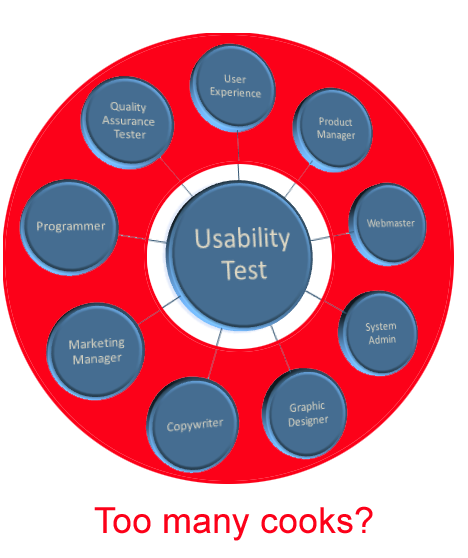In the tenth of our 12 days of LPO tips, SiteTuners takes you through team’s strengths and pitfalls as well as tips to avoid common mistakes.
Initially, usability test problems can be the opposite of corporate home page problems. With the corporate home page, everyone wants a piece of the real estate (but not everybody should have it). With usability tests, you need nearly everyone to make the tests work (but not everybody wants to participate).
Of course, later in the process, the problem becomes exactly the same – with so many people involved, how do you keep all these cooks from spoiling the same broth?
Where is everyone coming from?
To address this, you need to first be sensitive about what roles will be involved in the tuning tests, and what tasks the roles will perform. Depending on the size of your organization, multiple roles may be combined into one person, or a single role broken out into multiple stakeholders.
Marketing Manager
Why do you need them? They provide context. They understand the full scope of traffic acquisition activities, understand the larger business goals, and guard the key messaging themes.
Where are they coming from? They do not have a lot of time. As they formulate the marketing plan and oversee execution, they must use their time wisely, and evaluate options with you rather than build something from scratch. Come prepared, work out the type of test you want to run, note the conversion targets.
Programmers
Why do you need them? They are responsible for the functional aspects of your tests, like forms, mouse rollover behavior, and page flows.
Where are they coming from? They can view your tasks as additional load, and they tend to be poor judges of interface design and graphics. Make sure that what you want from a usability standpoint is clearly documented, and what you need from a visual standpoint is backed by mock-ups of the proposed designs.
Graphic Designers
Why do you need them? They are responsible for pictures, buttons, navigation menus, and in some cases, complete page and layout redesigns.
Where are they coming from? Some graphic designers can be more concerned about self-expression than business goals, and may want to turn your routine test element changes into more “fun” activities. Make sure you are managing visual, cognitive, and memory load, ensuring elements that need to be subtle are subtle, and keeping unnecessary elements off the page.
User Experience (UX)
Why do you need them? If this is not, well, you, UX people will help with the test plan, the elements, and the information architecture for your tests. You also need to find the gaps between the user roles and tasks, and your web page intent.
Where are they coming from? They are typically better at smaller scale tests. When you have multivariate tests with lots of variable interactions then they may not be the best people to tap for analysis. You may also want to consider automating the test for the confidence level, so what they can do what they are best at, which is connecting your page intent to things like the user’s decision process, and designing for usability goals.
Product Manager
Why do you need them? They tend to have approval powers for products tied to their products, can sometimes lead sales efforts that encompass conversion rate optimization, and can be your key contact if you need project-based people working on a project.
Where are they coming from? As with marketing managers, they do not have a lot of time. Figure out and present the math, but it’s best to keep it simple until you have a few successes under your belt. A-B tests usually work best to start off with.
Webmaster
Why do you need them? They have the technical background for element approval, javascript tags, quality assurance of implementation, and in some cases, access to web analytics.
Where are they coming from? Given that their job is to keep the web site running, some webmasters may view your activities as a threat. They can deny you access to areas you need and control areas that keep you from progressing at a reasonable rate. Some webmasters will ultimately focus on maintenance (status quo) rather than improvements that accompany risks. Get the information you need for discussions ahead of time – show which areas will be affected, gather data for areas you’d like to test, and follow guidelines closely.
System Administrators
Why do you need them? As webmasters are responsible for the web site, system admins are responsible for the network. They ensure security, rerouting traffic for tests, and keeping performance steady while tests are run.
Where are they coming from? As with webmasters, they have a stake in the status quo, only their concern is security and performance instead of guidelines and maintenance. They will have to vet the underlying technology for your tests – when you’re just getting started, choose an easily defensible strategy that just requires basic changes like javascript. You can defend and run more complex multivariate tests when you have a few wins in the books.
Copywriter
Why do you need them? They are responsible for headlines, body text, sales copy, the call-to-action, and other text elements.
Where are they coming from? They tend to be generalists. Make sure the users are kept in mind, and best practices for usability followed, like attempting to slash everything in half, and then slashing the rest in half again.
Quality Assurance Tester
Why do you need them? They ensure that all proposed changes to your website function properly before the changes go on the live site.
Where are they coming from? They are typically not assigned to QA tasks full-time, and they will usually just test for functionality and availability, not usability. Make sure that the people who designed the tests are not the same ones who execute them.
Next: “Reduce Risks from Unknowns by Completing Your Testing Action Plan.” SiteTuners covers the action plan.
Take your conversions to the next level.Learn how our experts at SiteTuners can help kickstart your conversion rate optimization process or get better results from your CRO efforts. Give us 30 minutes, and we’ll show you a roadmap to your digital growth! |


